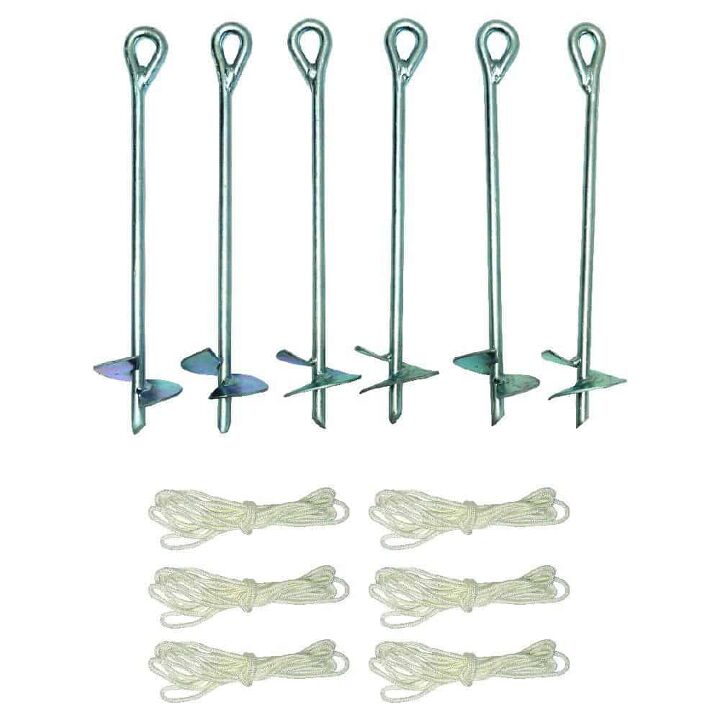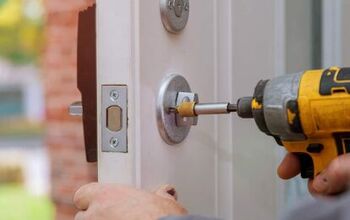How To Secure A Gazebo From Wind (5 Ways To Do It!)

Gazebos are an amazing way to bring leisure, value, and visual appeal to your backyard. They are a simple getaway that you can access without leaving your home, and that’s why gazebos are so sought after. On a windy day, however, they are at risk, so how do you secure a gazebo from the wind?
The best way to secure a gazebo from wind is with an anchor kit that has spiral or corkscrew pegs. Otherwise, you could drive standard 12” pegs into the ground and tether them to the gazebo with rope. You can also drill the gazebo into concrete or use gazebo weights and temporary walls to make them more wind-resistant.
Do You Need a Gazebo or Freestanding Porch Installers?
Get free, zero-commitment quotes from pro contractors near you.

How To Secure a Gazebo From Wind
It doesn’t take a lot of work to anchor a gazebo into the ground and secure it from the wind. You can secure a gazebo whether it is built over concrete or grass without spending a fortune. Let’s take a look at how you can protect your gazebo from blowing away in the wind.
1. Anchor Kit
You can safely protect your gazebo from the wind by using a simple and affordable anchor kit. Several companies, such as Eurmax and Ashman, sell anchor kits that are slightly different from one another. Most anchor kits feature spiral and corkscrew pegs which help fasten your gazebo firmly to the ground.
Anchor kits have pegs that you can drive deep into the ground for a tighter fit than a standard peg. You won’t have much luck with an anchor kit if the gazebo is built over concrete, however. If your gazebo is built over grass and dirt, an anchor kit is the best way to secure it from the wind.
You simply drive each between 4 and 6 pegs into the ground and run a strap through one that attaches to the gazebo. The top of the gazebo should have a loop for straps and the pegs will anchor it to the ground. Corkscrew and spiral pegs that come with anchor kits are the best way to ensure the wind won’t move your gazebo.
2. Weights
Weights are the best way to secure your gazebo from wind if it’s built over concrete, but it works over grass as well. You can anchor your gazebo without drilling into concrete by placing gazebo weights on the legs and base. Circular sandbags also work well to weigh down your gazebo so that the wind doesn’t blow it away.
You can safely secure your gazebo from the wind with between 80 and 110 pounds of weight. Expect to pay less than $20 for weighted bags or sandboxes that total 112 pounds. Weighted bags and sandbags are a great option because you can easily place them over the legs of your gazebo.
Metal weights are another great option because you can lay them flat to the ground-hugging the foot of the gazebo. Many cast iron gazebo weights have a small opening on one end so that you can slip it around the foot. Choose gazebo weights to secure your gazebo if you’re not able to anchor the gazebo into the ground.
3. Drill Gazebo Into Concrete
You can drill your gazebo into concrete if it is built over concrete and you are worried about wind damage. This requires that you attach a masonry bit to your drill so that you can create clean holes in the concrete. Drill a hole into the concrete where you want one of the gazebo legs to go and clean it out when you are done.
Use a small brush or pipe cleaner to get any debris out of the hole before you move on. Put a small wedge anchor into the hole and remove the nut so that you can move the gazebo leg over it. Slide the gazebo leg over the hole and look through the small hole in the gazebo leg.
You should see the wedge anchor in the hole, and now you can slip the washer onto the nut and screw it in place. Use a ratchet to tighten the nut and repeat those simple steps for the other 3-5 gazebo legs. It’s a simple process as long as you make sure that each hole that you drill is in line with the other gazebo legs.
4. Gazebo Walls
On a nice day, the last thing that you want to do is close up your gazebo with walls. However, when it’s windy, adding temporary walls to your gazebo can secure it from the wind. Many gazebos are compatible with vinyl walls that you can put up at any time, but they come in handy on windy days.
The walls keep the wind from flowing through the gazebo, and that, in turn, makes it more secure. You simply attach the vinyl walls to the top of the gazebo, or its legs. This seems like a simple practice, but it can fortify your gazebo to keep it from blowing away during strong winds.
You can also find polyester gazebo walls, which are just as effective as vinyl, but it’s ultimately up to personal taste. Look out for gazebo walls that match your gazebo and your taste, as long as they are sturdy. Gazebo walls won’t anchor your gazebo, but they will stop the wind from blowing through them and blowing it away.
5. Pegs
Anchor kits are the most effective way to anchor a gazebo, but standard pegs are helpful as well. The difference between standard pegs and anchor kits is that pegs don’t have spirals or a corkscrew shape. However, if you drive a peg into the ground and tether it to a gazebo with a rope, it will anchor the gazebo.
You need to make sure that you use at least 12” pegs so that it is deeply anchored to the ground. Pegs are affordable, and you can buy 6 of them for only $13 or less. Steel pegs are the best option because they are much more resistant to moisture and rust, especially in humid climates.
Tether the gazebo to the pegs by tying a rope from them to the top of the gazebo. This will keep the gazebo from blowing over or away on a windy day. A combination of pegs and rope is one of the most simple, affordable, and effective ways to secure a gazebo.
Related Questions
How much wind can the gazebo withstand?
There is no measurement of how much wind a gazebo can withstand, but wind is bad for gazebos. Windy storms can tear through gazebos and either blow them away or throw around any furniture under them. Gazebo walls can reduce the amount of wind that blows through a gazebo, and they pair well with weights and pegs.
Do gazebos add value to a home?
Yes, gazebos do add value to a home in the same way that other additions and renovations do. You can expect to get up to an 80% return on your investment if you install a gazebo. Gazebos make the backyard look better and serve to bump up your resale value by thousands of dollars.
Do gazebos require permits?
If your local Homeowners Association (HOA) or municipality considers a gazebo a building, you’ll need a permit. With that said, not all communities and counties consider gazebos to be buildings and you won’t need a permit. You can expect to pay between $60 and $150 on a permit if you are required to where you live.
Should a metal gazebo be grounded?
Yes, metal gazebos should be properly grounded to protect from potential harm or property damage during a storm. Metal gazebos are susceptible to blowing away, tipping over, and even lighting strikes which can cause damage. You should ground a metal gazebo by using steel and copper rods that are drilled into the ground to keep it in place.
Are gazebos waterproof?
Gazebos can be waterproofed if you use water-resistant tarps. Vinyl is the best material to use as a tarp to make your gazebo waterproof and keep water out.
Do You Need a Gazebo or Freestanding Porch Installers?
Get free, zero-commitment quotes from pro contractors near you.

What Did We Learn?
Anchor kits with spiral and corkscrew pegs are the easiest way to secure a gazebo from the wind. The spiral and corkscrew shape makes the pegs have a tighter fit into the grass. Standard pegs also work quite well if you drive them into the ground and tether them to the gazebo with a rope.
You can also put up vinyl and polyester gazebo walls that minimize the airflow to secure the gazebo from the wind. If your gazebo is built over concrete, you can drill it into the ground so that it is fastened and safe from wind gusts. Otherwise, you can simply put sandbags at the base of your gazebo’s legs so that they won’t budge in the wind.
There are also gazebo weights that are generally flat and can fit around the bottom of the legs on your gazebo. Gazebo weights are the quickest way to secure your gazebo, and they only cost $20, or even less. You can secure your gazebo from the wind without spending an arm and a leg and won’t take you much effort.
Related Guide

Nick Durante is a professional writer with a primary focus on home improvement. When he is not writing about home improvement or taking on projects around the house, he likes to read and create art. He is always looking towards the newest trends in home improvement.
More by Nick Durante
































